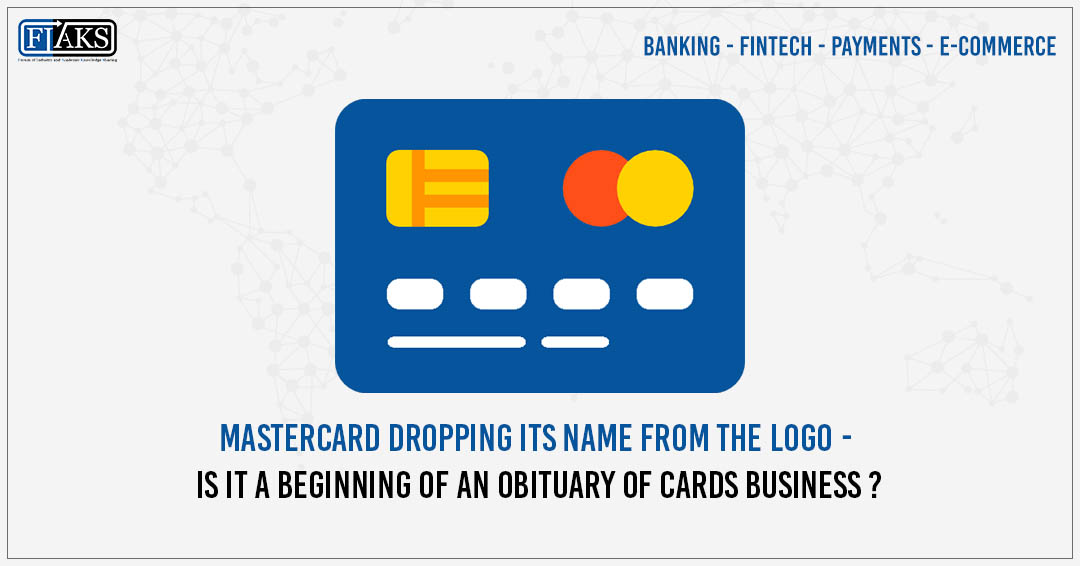Several Founders, Co-Founders, CXO Bankers, CXO Fintech professional & people who participated in the ePanel discussions:
- Mr. Yasir Imran, Founder & CEO, Clay N Potter
- Mr. Prabhanjan Dhotre, Director, Beehive Capital Advisors Private Ltd
- Mr. Narayan Rao, Chief Services Officer, Suryoday Small Finance Bank
- Mr. Abhay Kulkarni, former General Manager Sales, Worldline Global
- Mr. Muthu Krishnan, General Manager- Merchant Acquisition at India Transact Services Ltd
- Mr. Ruchit Jangid,eBusiness, Thomas Cook
- Mr. Ratnakar V, DVP Rural Lending & Payments, Axis Bank
- Mr. Sunil Kulkarni, Joint Managing Director, Oxigen Services (India) Pvt Ltd
- Mr. Shirsha Ghosh, Co-Founder, Torit Innovations
- Mr. Neeraj Chandra, Head of Operations, Abu Dhabi Commercial Bank
- Mr. Vikas R Panditrao, Co-Founder, Forum of Industry Academic Knowledge Sharing (FIAKS)
- Many other CEO/CXO Bankers & Fintech professionals on FIAKS Forum
In January 2019, Mastercard dropped their name from the logo, leaving just 2 intersecting circles as a logo. This news sprouted a very interesting discussion in the FIAKS community. First, some questions arose –
Question 1: Can anyone trademark intersecting circles in generic colors?
Question 2: Isn’t it indicating a trend that card business will go Nokia way and future is for the electronic form of cards in the mobile handsets?
Below is an excerpt of an article in “The Drum” in which the CEO of Mastercard explains why the brand dropped its name from its logo. As consumer interaction with devices changes the real estate in digital is coming down dramatically. So it’s important to show up in a prominent way to attract attention on the one hand and on the other to make the right impact. In the given real estate for a smartwatch or a smartphone, the space available is not big and to have 10 characters for Mastercard competing with – or in relation to – the two interlocking circles. If you take off the name and occupy the whole space with red and yellow interlocking circles the visibility is more prominent.”
Next question that arose in the community was – Why do you need a physical card for credit though?
An expert in the community shares that other than cards, all other form factors have a dependency on the internet connection for customer device and more importantly customer education on how to use it which brings two additional dependencies for completion of the transaction. A merchant is more interested in selling and would want fewer variables in digital transaction success rate as a result of customer devices/operation. On the other hand, the customer would also want to give the card and let merchant do the work. We, in India, draw comfort in “retail assist” than “self-service”. Remember, washing machines were meant to replace maids in households and the very old advert of “Bye Bye Kanta Bai” was aired on TV for quite a long time. The result was that “Kanta Bai” (maid) did not go, but she started using a washing machine.
Another member commented that with internet penetration and digital literacy growing at an exponential rate, there is no scope for physical cards business to survive.
The washing machine was a great example but the card in physical format doesn’t have any future in the credit card business. The debit cards still have the market for some years but surely credit card business will see obituary soon.
Another Member said this decision looks to be a realization among card associations that physical cards businesses will be over & out. Everything in payment & banking will eventually converge to mobile handsets. A leader in the community says that if you think logically, the physical card has no value proposition at all in credit business as credit limit is electronically stored, Payments are made without need of swiping the card at the POS machines (eg Samsung Pay) and Credit Card is rarely used for Cash withdrawal due to cash advance fee
However, cards in the physical format are here to stay for a little longer time in Debit Cards Business as customers will continue to use it for cash withdrawal from ATM. So I feel
- The credit cards will go virtual
- The debit cards will remain physically plastic until all the ATMs start accepting virtual cards for withdrawals ie Cardless withdrawal
Register and Read the entire discussions

